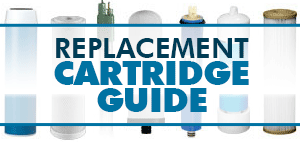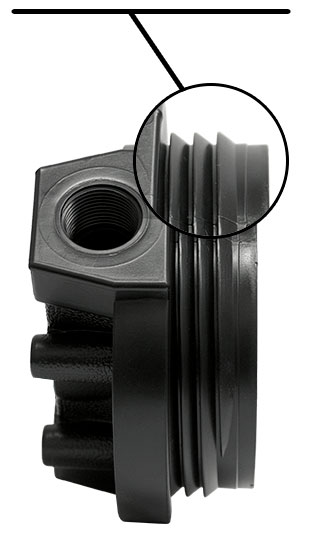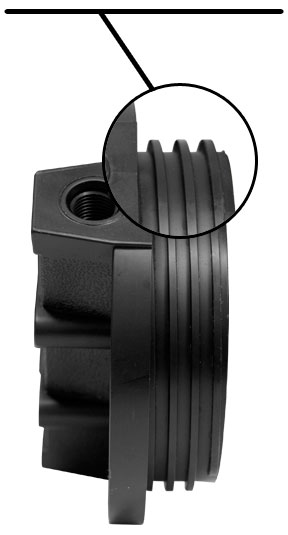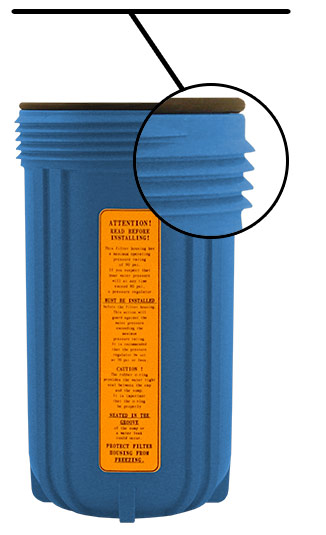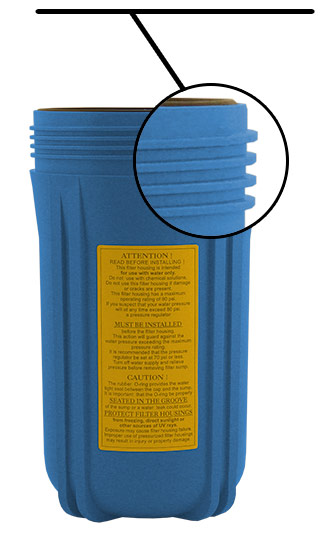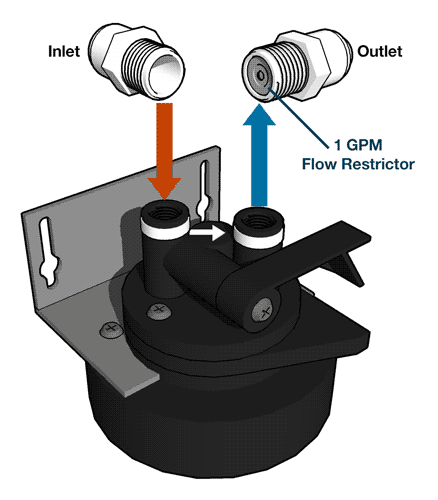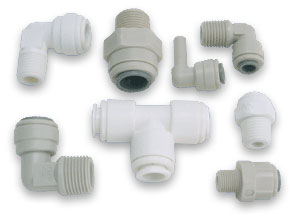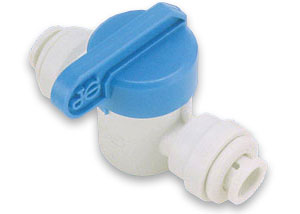Cloudy
Source: USGS.govWhite, Clears After a Minute
Once in a while, you get a glass of water and it looks cloudy; maybe milky is a better term. After a few seconds it miraculously clears up! The cloudiness might be caused by the water in the pipes being under a bit more pressure than the water in the glass, but is more likely due to tiny air bubbles in the water. Like any bubbles, the air rises to the top of the water and goes into the air, clearing up the water. Cloudy water, also known as white water, is caused by air bubbles in the water. It is completely harmless.
It usually happens when it is very cold outside because the solubility of air in water increases as water pressure increases and/or water temperature decreases. Cold water holds more air than warm water. In the winter, water travels from the reservoir which is very cold and warms up during its travel to your tap. The air that is present is no longer soluble, and comes out of solution.
Also, water pressure has something to do with it. The water is the pipes is pressurized to a degree (which helps to get the water all the way from the water tower to your home). Water under pressure holds more air than water that is not pressurized. Once the water comes out of your tap, the water is no longer under pressure and the air comes out of solution as bubbles (similar to a carbonated soft drink). The best thing to do is let it sit in an open container until the bubbles naturally disappear.
Green Slime Inside Pipes
Heterotrophic bacteria are non-coliform species of bacteria that utilize an organic substance for its development. Heterotrophic bacteria can be widespread throughout a water system. The presence of heterotrophic bacteria in drinking water is not an indication that the water presents a health risk. Rather, no specific significance or health standards are associated with these non-pathogenic non-coliform bacteria.
High HPC counts indicate ideal conditions for bacterial regrowth and should be corrected. Bacterial regrowth can lead to pipe corrosion, encourage slime growth, increase the need for disinfectants, cause foul-tasting water, and harbour secondary respiratory pathogens (ex. Legionella). Thus, HPC can be used as a marker for the underlying causes of some aesthetic problems (WHO, 2002).
Brown Discoloration, Clears After a Running Tap
The internal plumbing of your house may be the culprit if discolored water only appears for a minute or two after your tap is turned on. When the zinc coating on the inside of galvanized iron pipe begins to wear thin, water becomes discolored as it comes in contact with bare iron. The longer the water sits in the pipes, the worse the discoloration will be. That’s why you are most likely to notice the problem first thing in the morning or when you have just returned from school or work. After running your tap for a few minutes, clean water from your water heater or water main will replace the discolored water. Since iron is an essential nutrient, this condition poses no health hazard. If the discoloration bothers you, however, flush the tap until the water becomes clear, saving the water for iron-loving plants.
Persistent Brown Discoloration
Sediments in water mains sometimes get stirred up when fire hydrants are used and when the flow of water in mains is changed. These sediments may cause your water to turn brown or yellow. Wait 30 to 40 minutes after you notice the discolored water, and try turning on the cold water in your bathtub for a minute or two. You’ll probably notice that it clears right up, since sediments settle quickly back to the bottom of water mains. Discolored water due to sediments such as these poses no health threat, but for aesthetic reasons you should avoid doing laundry until the water clears up.
Hard Water
What is Hard Water?
Water hardness is the most common problem found in the average home. Hard water is water that contains dissolved hardness minerals above 1 GPG. Calcium, Magnesium, and Lime are the most common minerals to cause hard water.
Learn more about Hard WaterHealth & Disease
Cryptosporidiosis
Cryptosporidiosis is a disease caused by the parasite Cryptosporidium parvum, which as late as 1976 was not known to cause disease in humans. Until 1993, when over 400,000 people in Milwaukee, Wisconsin, became ill with diarrhea after drinking water contaminated with the parasite, few people had heard of either Cryptosporidiosis or the single-celled protozoan that causes it.
Since the Milwaukee outbreak, concern over the safety of drinking water in the United States has increased, and new attention has been focused on determining and reducing the risk for Cryptosporidiosis from community and municipal water supplies.
Learn more about Cryptosporidiosis Learn more about Other Types of ContaminantsOdor
Minor, Musty Smell
If it is a minor, or low-level smell, you might be able to solve it with a small, point-of-use carbon filter. You can place these types of filters on the water line going to the cold water where you draw you drinking water. Or, you might solve it with a whole-house filter on your incoming water line to filter all of the water inside your home.
Because carbon removes smells by Adsorbtion, i.e., the smell "sticks" or "adheres" to the carbon particles, you must be careful not to exceed the manufactures recommended flow — some filters even have a flow restriction built in them. If you run water through them too fast, you will not remove the smells. Whenever you place a carbon filter in your water line, you must be sure to replace the element and sanitize the housing on a regular basis. Carbon filters remove organics from water, and the bacteria found in water like to eat organics — the carbon filter is a nice, dark place, just full of food for them to grow and reproduce in. Regular and routine replacement will help prevent any buildup of bacteria in the cartridge.
Strong, Rotten-Egg Smell
Strong, rotten-egg odors in the raw water is usually the result of the decomposition of decaying underground organic deposits. As water is drawn to the surface, hydrogen sulfide gas can be released to the atmosphere. In strong concentrations, this gas is flammable and poisonous. It rapidly tarnishes silver, turning it black. It is toxic to aquarium fish in sufficient quantities. As little as 0.5 ppm hydrogen sulfide can be tasted in your drinking water.
Strong, Musty Smell
If you are unlucky enough to have this problem, you should look for a company that has local experience in dealing with this problem. There are three basic ways to solve this problem for homeowners.
Staining
Red Stains In Sinks and on Fixtures
Oxidized Iron
This type of iron is usually found in a surface water supply. This is water that contains red particles when first drawn from the tap. The easiest way to remove this type of iron is by a fine mechanical filter. A cartridge type filter is usually not a good solution, due to the rapid plugging of the element. Another method or removal is by feeding a chemical into the water to cause the little particles of iron to clump together, and then fall to the bottom of a holding tank, where they can be flushed away.
Soluble Iron
Soluble iron is called “clear water” iron. After being drawn from the well and contacting the air, the iron oxidizes, or “rusts,” forming reddish-brown particles in the water. Depending on the amount of iron in the water, you may solve this problem with a water conditioner, or a combination of softener and filter. You may use an iron filter that recharges with chlorine or potassium permanganate, or feed chemicals to oxidize the iron and then filter it with a mechanical filter. You can sometimes hide the effects of soluble iron by adding chemicals that, in effect, coat the iron in the water and prevent it from reaching oxygen and oxidizing.
Colloidal Iron
Colloidal iron is very small particles of oxidized iron suspended in the water. They are usually bound together with other substances. They resist agglomeration, i.e., the combining together of like substances forming larger, heavier, more filterable ones, due to the static electrical charge they carry. This iron looks more like a color than particles when held up in a clear glass, as they are so small. Treatment is usually one of two: Feed chlorine to oxidize the organic away from the iron, thus allowing agglomeration to occur, or, feeding polymers that attract the static charge on the particles, forming larger clumps of matter that is filterable.
Iron Bacteria
Iron bacteria are living organisms that feed on the iron found in the water, pipes, fittings, etc. They build slime all along the water flow path. Occasionally, the slimy growths break free, causing extremely discolored water. If a large slug breaks loose, it can pass through to the point of use, plugging fixtures. These types of bacteria are becoming more common throughout the United States. If you suspect bacteria iron, look for a reddish or green slime buildup in your toilet flush tank. To confirm your suspicions, gather a sample of this slime and take it to your local health department, or water department for observation under the microscope. This type of iron problem is very hard to eliminate. You must kill the bacteria, usually by chlorination. You must use high amounts of chlorine throughout your plumbing system to kill all organisms. You may find it necessary to feed chlorine continuously to prevent regrowth. A filter alone will not solve this problem.
Organic-Bound Iron
When iron combines with tannins and other organics, complexes are formed that cannot be removed by ion exchange or oxidizing filters. This iron may be mistaken for colloidal iron. Test for tannins; if they are present, it is most likely combined with the iron. Low level amounts of this pest can be removed by use of a carbon filter, which absorbs the complex. You must replace the carbon bed when it becomes saturated. Higher amounts require feeding chlorine to oxidize the organics to break apart from the iron and cause both to precipitate into a filterable particle.
Blue or Green Stains In Sinks and on Fixtures
You either have copper in your water supply, or you have copper pipes and corrosive water. Test for copper in your water. Test the pH, total dissolved solids content and the oxygen content of your water.
Copper in the Water Supply
Copper can be removed by ion exchange, i.e., a water softener. The removal rate is about the same as it is for iron.
Copper Pipes & Corrosive Water
If your pH is from 5 to 7, you may raise it by passing the water through a sacrificial media. By sacrificing calcium carbonate into the water, the corrosively will be reduced. If the pH is below 5, you will need to feed chemicals into the water.
If the corrosivity is caused by excess oxygen, the hot water will be much more corrosive than the cold. Treatment is by feeding polyphosphate or silicates to coat and protect the plumbing, or to aerate the water to release the excess oxygen.
Testing & TDS
When Should I Test?
Several factors will influence when and how often you test your water. Where do get your water from? Has that source changed? Have you done any plumbing changes lately? Is there reason to believe that your water is contaminated? Is there a sickness or illness in your family affecting more than one person and over a longer than normal time period?
If you receive your water from a “Public Supply”, i.e., a municipal supply, or a supply that provides water to more than 25 persons for 60 days per year (some states are different — check with YOUR local water department), you can be fairly certain that the water supply is checked on a regular basis. The frequency of the testing is based on the number of people served, and may vary from more than once per week to once per month, or even less. Under these conditions, test when you move into a new residence to acquire a “base line” of contaminant level, if any. Retest every three years, unless you have reason to believe that something has changed that could affect the quality of your water.
If you have a private well, you are the only person who is responsible for the water your family drinks and bathes in. I recommend testing by your local Health Department every six months for Bacteria and Nitrate. These two tests serve as indicators for other types of contamination — that is not to say forget the other tests; just that if you get a “bad” test from them, you should also retest for the other types of contaminants as well. Private wells should be tested on a regular basis for Pesticides, Herbicides, Metals, Organic and Inorganic chemicals and volatiles. Currently, no laws govern the frequency of such testing — that is why I say YOU are the only person responsible for your family’s water. I recommend an initial test (for a base line), and then at least once per year. Remember, one day after testing and finding “no contaminants,” your source could become contaminated.
What Could I Test For?
Coliform bacteria are a group of microorganisms that are normally found in the intestinal tract of humans and other warm blooded animals, and in surface water. The presence of these organisms in drinking water suggest contamination from a surface or shallow subsurface source such as cesspool leakage, barnyard runoff or other source. The presence of these bacteria indicate that disease-causing (pathogenic) organisms may enter the drinking water supply in the same manner if preventive action is not taken. Drinking water should be free of coliforms.
Cysts and viruses are microbiological contaminants, usually found in surface water supplies. Giardia Lamblia cysts can cause giardiasis, a gastrointestinal disease. Another “bug” getting a lot of attention lately, is Cryptosporidium, single-cell parasite measuring about 2 – 5 microns in diameter. Many surface water supplies contain this pest, which also comes from the intestine of warm blooded animals.
Nitrate in drinking water supplies may reduce the oxygen carrying capacity of the blood (cyanosis) if ingested in sufficient amounts by infants under 6 months of age. This could cause a disease called “methemoglobinemia”, or “blue baby” syndrome. The EPA has established a maximum contaminant level (MCL) for nitrate at 10 mg/l (ppm) measured as N. Unlike coliform or other types of bacteria, boiling the water will actually INCREASE the amount of nitrate remaining in the water, increasing the danger to infants. If you have high nitrate water, either treat it with an approved treatment methodology or find another source: Boiling will only make it worse!
Lead is now known to leach from older sweat joints in copper pipe. As the water sits in the pipes, small amounts of lead ‘dissolve’ into the water, contaminating it. Lead is particularly harmful to small children as they more rapidly absorb the toxic substance into their systems. The EPA has estimated that more than 40 million U.S. residents use water that contains more than the recommended levels.
See a list of contaminants and their possible health effectsTotal Dissolved Solids (TDS)
The total weight of the solids that are dissolved in the water, give in ppm per unit volume of water. TDS is determined by filtering a given volume of water (usually through a 0.45 micron filter), evaporating it at a defined temperature (usually 103-105 degrees Celsius), and then weighing the residue.
An Easy Way to Test
National Testing Laboratories, Inc. in Ypsilanti has a five bottle testing kit, which is supplied by many water quality professionals across the nation. You simply follow the directions in the kit and return the sample to the lab. They test your sample and then report to you. Your test results will be a two page report showing contaminant level, a cover letter explaining the test results and what you should do.
View Drinking Water Testing Kits from National Testing Laboratories




















